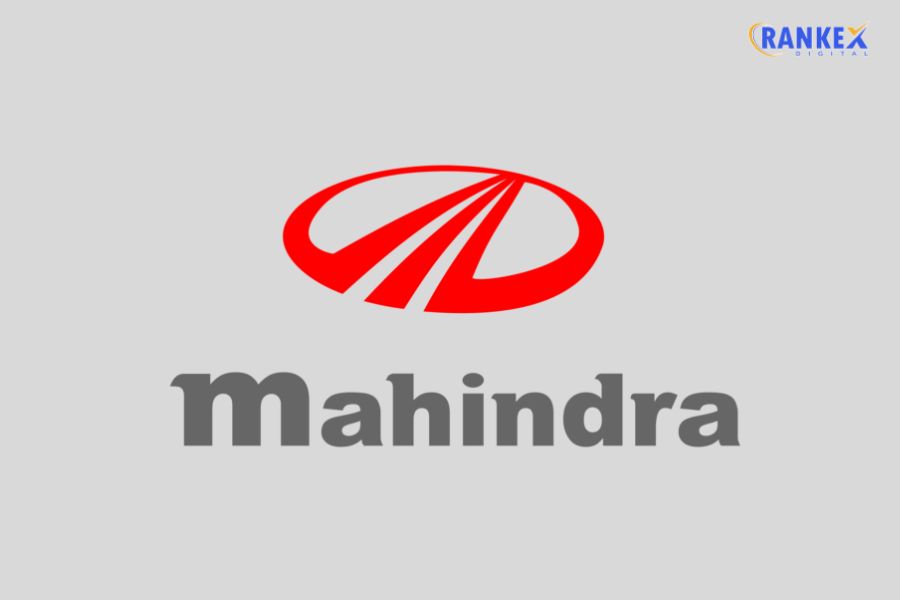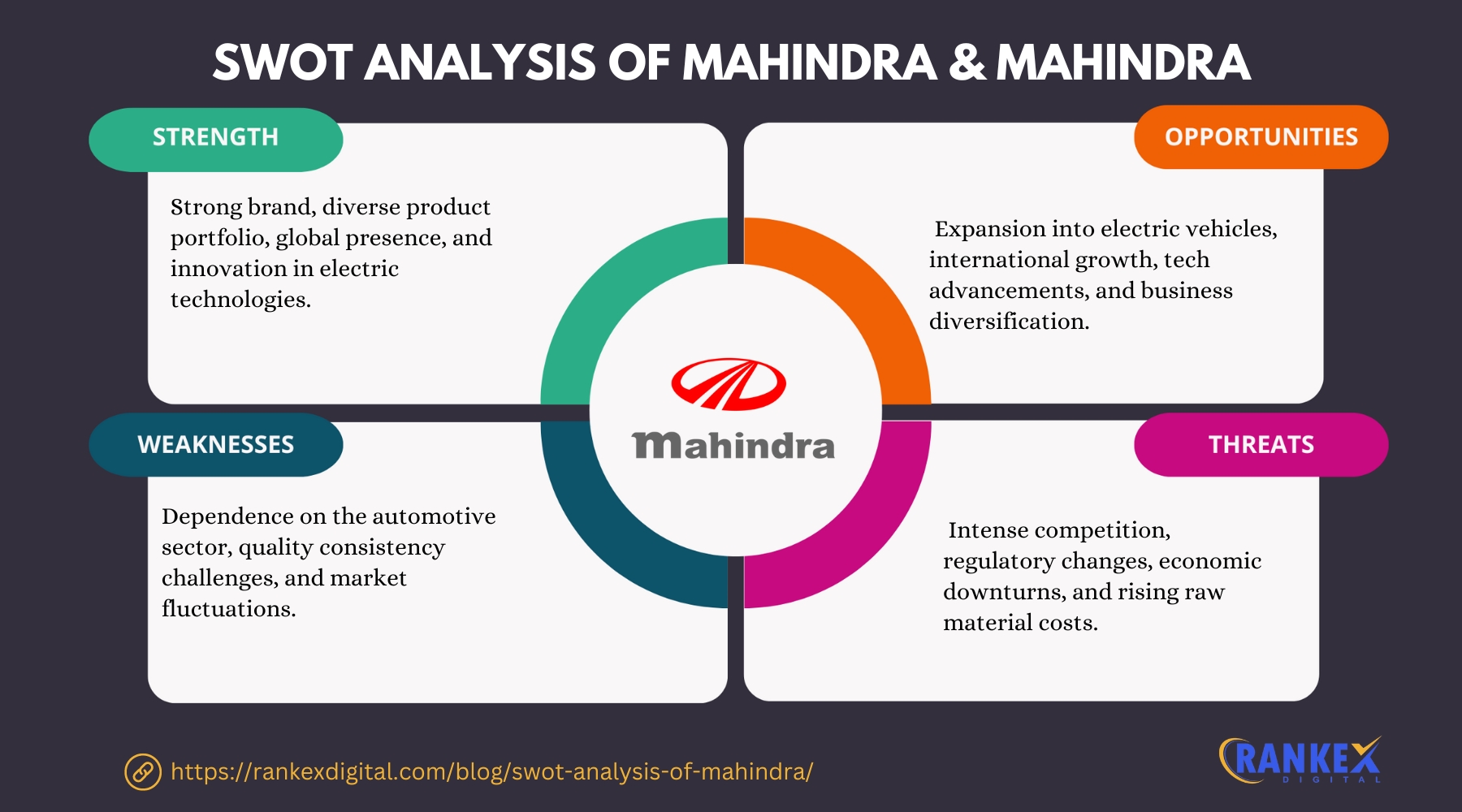Mahindra & Mahindra (M&M) is one of India’s largest multinational corporations, primarily known for its dominance in the automotive and agricultural sectors.
With a strong presence in both domestic and international markets, M&M has established itself as a major player in multiple industries, including automotive manufacturing, aerospace, defense, finance, and information technology.
This updated SWOT analysis of Mahindra & Mahindra provides insights into M&M’s current standing in the market, along with potential growth opportunities and challenges.
Table of Contents
Overview of Mahindra & Mahindra

| Founder | J.C. Mahindra & K.C. Mahindra |
|---|---|
| Year Founded | 1945 |
| Origin | Ludhiana, India |
| Industry | Automotive, Agriculture, Technology |
| Annual Revenue | $19 Billion (FY 2023) |
| Employees | 250,000+ |
Mahindra & Mahindra is renowned for its robust range of utility vehicles, tractors, and two-wheelers. It also has diversified into financial services, IT, real estate, and hospitality, making it a conglomerate with a far-reaching impact across industries.
Current News on the Market on Mahindra & Mahindra
- Electric Vehicles Expansion: M&M is aggressively expanding its electric vehicle (EV) segment with the launch of new models, including the all-electric XUV700, as part of its ambitious plan to lead the EV market in India.
- Partnerships for Technological Innovation: Mahindra has entered into multiple strategic partnerships, such as its collaboration with Volkswagen for EV platform development and with Qualcomm for autonomous driving technology.
- Agriculture Sector Dominance: M&M continues to hold a leading position in the agricultural sector, with its tractors and farming equipment in high demand both in India and international markets.
- Sustainability Initiatives: Mahindra is focusing on reducing its carbon footprint and has committed to becoming carbon neutral by 2040. The company has also invested in renewable energy projects and eco-friendly vehicle manufacturing.
- Strong Financial Performance: M&M reported solid financial growth in FY 2023, driven by increased sales in the utility vehicle and tractor segments, along with growth in its financial services division.
SWOT Analysis of Mahindra & Mahindra

Strengths of Mahindra & Mahindra
- Diverse Business Portfolio
Mahindra’s presence across various sectors—automotive, agriculture, IT, aerospace, financial services—provides the company with multiple revenue streams, reducing its dependence on any single market. - Leadership in Agricultural Equipment
M&M is the largest tractor manufacturer in the world by volume, with a strong foothold in both domestic and international markets. Its dominance in the agricultural sector has positioned it as a leader in mechanized farming. - Robust R&D and Innovation
Mahindra’s continuous investment in research and development has allowed it to stay ahead in technological innovation, especially in electric vehicles, autonomous driving, and smart farm equipment. - Strong Brand and Market Presence
With a strong brand reputation, Mahindra has a loyal customer base, particularly in the utility vehicle and tractor segments. Its name is synonymous with rugged, reliable, and cost-effective products in the Indian market. - Sustainability and ESG Commitment
Mahindra has a strong focus on sustainability, with initiatives aimed at reducing emissions, increasing the use of renewable energy, and promoting eco-friendly technologies in its vehicles and operations.
Weaknesses of Mahindra & Mahindra
- Dependence on Indian Market
While M&M has a global presence, a significant portion of its revenue comes from the Indian market. This makes the company vulnerable to changes in India’s economic conditions, government policies, and market demand. - Limited Presence in Passenger Vehicle Segment
Despite its success in the utility vehicle market, Mahindra has struggled to capture a significant share in the passenger car segment, where competitors like Maruti Suzuki and Hyundai dominate. - Volatility in Raw Material Prices
The automotive and manufacturing industries are heavily affected by fluctuations in raw material prices, such as steel and aluminum, which can impact Mahindra’s profit margins, especially in price-sensitive markets. - Quality Issues in Certain Models
Mahindra has faced challenges related to the quality and reliability of certain vehicle models, leading to recalls and negative customer feedback, which can hurt brand reputation in the long term. - Delayed EV Rollout
While Mahindra has made strides in the electric vehicle market, its EV rollout has been slower compared to competitors like Tata Motors. Delays in launching new EV models could limit its competitiveness in the growing electric vehicle sector.
Opportunities for Mahindra & Mahindra
- Expansion of Electric Vehicles Portfolio
With the global shift towards sustainable transportation, Mahindra has a tremendous opportunity to expand its electric vehicle portfolio. The company can leverage its R&D capabilities and strategic partnerships to introduce more affordable and advanced EV models. - International Market Growth
Mahindra’s agricultural equipment and utility vehicles have strong potential in emerging markets in Africa, Southeast Asia, and Latin America. Expanding its international footprint can drive future revenue growth. - Smart Farming Solutions
The growing demand for precision farming and smart agricultural solutions presents an opportunity for Mahindra to introduce new technologies, such as autonomous tractors and connected farm equipment, to meet modern farming needs. - Digital Transformation and IoT Integration
As industries move towards digitization, Mahindra can enhance its product offerings by incorporating Internet of Things (IoT) technologies, connected vehicle solutions, and AI-driven services in both its automotive and agricultural businesses. - Partnerships and Acquisitions
Mahindra can explore further partnerships and acquisitions, especially in the technology and electric mobility sectors, to enhance its market position and technological capabilities.
Threats to Mahindra & Mahindra
- Intense Competition in the Automotive Sector
The automotive industry is highly competitive, with established players like Tata Motors, Maruti Suzuki, and Hyundai posing significant challenges to Mahindra’s market share. Additionally, new entrants in the EV space could intensify competition. - Regulatory and Environmental Policies
Changing government regulations related to emissions, fuel efficiency, and environmental standards could increase operational costs and force Mahindra to adapt quickly to avoid penalties. - Economic Downturns
Economic slowdowns or recessions in key markets, particularly in India, can negatively impact demand for automobiles, agricultural equipment, and other Mahindra products. - Rising Costs of Raw Materials and Supply Chain Disruptions
Fluctuations in the cost of raw materials and supply chain disruptions caused by global crises, such as pandemics or geopolitical tensions, can lead to production delays and increased costs, affecting profitability. - Technological Disruption
Rapid technological advancements in the automotive industry, such as autonomous driving and electric mobility, require continuous innovation. Failure to keep up with these trends could leave Mahindra trailing behind more technologically advanced competitors.
Competitors of Mahindra & Mahindra
- Tata Motors
Tata Motors is a direct competitor in the automotive and EV space, with a strong presence in both commercial and passenger vehicle segments. Tata’s rapid expansion into electric vehicles poses a significant challenge to Mahindra. - Maruti Suzuki
As the leader in India’s passenger vehicle market, Maruti Suzuki competes with Mahindra in the compact and small SUV segments. Its stronghold in the affordable car segment limits Mahindra’s market share in this space. - John Deere
In the agricultural equipment space, John Deere is one of Mahindra’s major global competitors, offering advanced farming solutions and equipment that cater to modern farming needs. - Ashok Leyland
Ashok Leyland competes with Mahindra in the commercial vehicle segment, particularly in heavy trucks and buses, which are vital to Mahindra’s automotive division. - Hyundai Motor India
Hyundai’s dominance in the passenger vehicle segment, particularly in sedans and compact SUVs, presents strong competition for Mahindra’s automotive business in India.
Conclusion
Mahindra & Mahindra continues to be a powerhouse in the Indian automotive and agricultural equipment industries, with a diversified business portfolio that mitigates risks and creates multiple avenues for growth.
However, to maintain its competitive edge, Mahindra must address challenges such as competition in the EV sector, reliance on the Indian market, and the volatility of raw material costs.
By focusing on innovation, sustainability, and international expansion, Mahindra is well-positioned to capitalize on opportunities and drive growth in 2025 and beyond.
Frequently Asked Questions
1. What are Mahindra’s main strengths?
Mahindra’s main strengths include its diverse business portfolio, leadership in agricultural equipment, robust R&D, and strong brand presence in India.
2. What are Mahindra’s weaknesses?
Key weaknesses include dependence on the Indian market, limited success in the passenger vehicle segment, and challenges related to the cost of raw materials and supply chain management.
3. How is Mahindra expanding in the electric vehicle market?
Mahindra is expanding its electric vehicle offerings with new models like the electric XUV700 and partnerships with global companies to develop advanced EV technology.
4. What are the opportunities for Mahindra in 2025?
Opportunities include expanding its EV portfolio, growing in international markets, introducing smart farming solutions, and leveraging digital transformation in its product offerings.
5. Who are Mahindra’s main competitors?
Mahindra’s main competitors include Tata Motors, Maruti Suzuki, John Deere, Ashok Leyland, and Hyundai Motor India.











